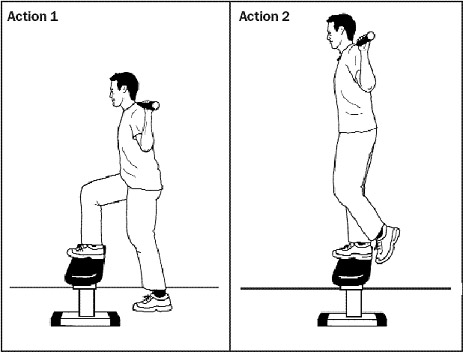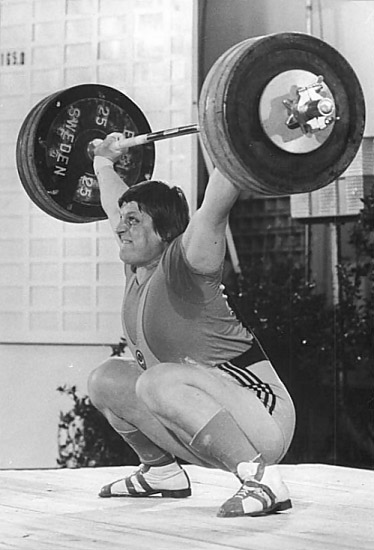AUGUST, 2010
CHAMPIONSHIP MEETS
DIVISION I
Battling The Elements
DIVISION II
Thunder In The Queen City
DIVISION III
Upsets and Dominance
USATF
Patterson Steals the Show
C
OMING TO AMERICADiamond League hits the Big Apple
ON THE BIG STAGE
Kara Patterson hammer
BRITNEY
HENRY
Perseverance and mental toughness
BILL
SCHMIDT
Americaís Last Olympic jav medalist
L
ESS IS MOREHow to maximize your training
Step-Ups
A great alternative
DISCUS ADAPTATIONS
Coaching the physically challenged
A Great Alternative
STEP-UPS
By Leif Arrehnius,
Brigham Young University
Since the early 1900ís, the squat lift has been the bread and butter for building strength in the legs. Almost every athlete in every sport has performed a version of the squat lift in their training. The problem with squats is that many athletes donít like to do them because they are hard and in some cases when done improperly will cause injury and pain. The problem is that due to the influences of power lifting and strongman sports, there are a lot of athletes that believe that squats are the only lift they can do for their legs. The squat lift works the legs very well and is a great lift but there are better alternative lifts that can be used instead that eliminate the risk of injury and pain. The lift that I believe is a great alternative is the step-up.
Anatoly Bondarchuk, the former Soviet throws coach did some studies on
whether back squats or step-ups would be most useful to his athletes. His
studies led him to conclude that a particular form of what weíll call the
high step-up had two significant advantages over the standard back squat.
Bondarchuk concluded that high step-ups, firstly, produce greater gains in
thigh and hip power and secondly, cause fewer injuries. He started having
his athletes use step-ups instead of squats and convinced many other coaches
to do the same. Many of the athletes using step-ups began to make gains in
power that they werenít doing back squats. Bondarchuk concluded due to his
studies that heavy back squats are potentially dangerous to the structure of
the lower back. Recent studies have shown that the back squat places a load
on the structure of the lower back in the bottom position that is at least
twice as heavy as the load on the bar. According to Bondarchuk, the faster
you descend and the faster you reverse direction and begin to arise from the
bottom in a squat, the greater the load on the lower back will be and the
greater the chance of injury. Also as athletes try to increase weight in the
squats, it gets harder to maintain good technique. Bondarchuk concluded that
it would be safer to use a form of weighted step-up.

Figure 2
The Step-up is done by stepping up onto a platform with some form of weights and then stepping back down from it. Although it is an incredibly simple exercise, there are a few variations and things to be aware of. The ideal position for the leg to be in at the start of the step-up should be with hamstrings parallel to the ground. This basic exercise works the hips and thighs, and by adjusting the step height, you can favor either more of the quadriceps or the hamstrings. A higher step works the hamstrings harder and a lower step targets the quadriceps. So if an athlete is weak in the hamstring area, he should use a slightly higher bench to step up onto to. According to research done by Osse Aura, a professor of biomechanics at the Finnish Institute of Physical Education, the hamstring muscles should be approximately 75% as strong as the quadriceps muscles. If that ratio is not maintained, the chance of injury increases, while the chance of maximum performance decreases. If the quadriceps of a certain athlete are too strong, that athlete should use a higher than normal box height and thus place more stress on the hamstrings. If, on the other hand, an athleteís hamstrings are too strong, the box height will be lowered so that the quadriceps may be stressed more completely. In addition to the step height, speed and number of reps both play crucial roles in determining the effectiveness of this exercise. These general rules usual apply: the reps will be lower and the breaks longer when training for maximum strength and the reps higher/breaks shorter for hypertrophy goals.
According to the article Bulgarian Leg Training Secrets written by Angel
Spassov and Terry Todd, the Bulgarian
and Soviet Olympic weightlifters both abandoned squats and made their lifts
in the snatch and clean and jerk higher than ever before. They use the
example of Leonid Taranenko, the current holder of the world record in the
clean and jerk in the superheavyweight class to prove this claim. Taranenko
has done the clean and jerk with a weight of 586 pounds. It is perhaps more
amazing that Taranenko didnít do any type of squat for four years before
breaking the world record. Besides his practice on the snatch and clean and
jerk, the only form of heavy leg training that Taranenko does is the high
step-up with weights. One thing coaches in the Soviet Union and Bulgaria
noticed was that those athletes, both lifters and those in other sports, who
dropped the squat and used the high step-up developed more complete
muscularity than those who simply squatted. Many of the coaches say that the
legs of those who work hard on the high step-up look more like those of
someone who did sprinting and jumping as well as squatting. Apparently, the
balance required in the high step-up calls more muscles into play, producing
fuller, shapelier development.

Figure 2
I have had knee problems my whole career that haveplagued my performance.
My older brother and I also have a genetic back disease called Shermanís
syndrome, which causes daily pain. I have done many sets and reps of squats
in pain due to tendonitis of my knees, back problems, and foot injuries. As
a thrower it is important to have legs as strong as they can be since all
power in the throwing events is produced in the legs. Because of injuries
and problems I have had, I decided this year to implement more step-ups into
my program. Some variations I have implemented this year are the parallel
step-up, the high step-up for my hamstrings, the low step for my quads, and
a fun variation of the lateral step up which helps with stabilizing muscles
in the legs, such as the adductor and abductor muscles. These lifts have
helped me gain leg strength without the normal pain I have been accustomed
to. After a couple of months this season of doing this, I have noticed that
my knees are feeling better and my back is not in pain which has helped
helped not only my throwing but also my other athletic performances. I have
also been able to sleep better and perform daily functions with more ease.

Leif and Niklas Arrhenius
When my older brother returned home from serving an LDS mission, and knowing the problems his back would have with squatting, he decided to do step-ups in order to help him get back into shape. My brother has always been a big back squatter, but he didnít want to cause the stress and pain that would come with heavy back squatting. He decided to do step-ups for 3 months to help him recover and get his legs back into shape for throwing. He saw huge gains in a short amount of time and noticed that his legs got their strength back sooner than any other major muscle groups in his body. That track season proved to be a very successful one as he improved all of his personal bests from before his 2-year mission. He attributes some of that success to the gains he was able to make pain free through step-ups. I recently did some squats to see how they would feel for my body. While doing them I noticed that I had reduced pain, and I felt more stabilized while performing the lift and was able to lift a big amount for me. I have concluded that implementing step-ups into my program has not only helped my over all body strength but has also helped me gain the leg strength I need without causing pain. I also feel that doing both step-ups and squats in the same program is beneficial and both lifts can help the other have gains. I have seen gains in my overall lifting strength especially in such lifts as snatch and cleans and I have seen gains in my throwing distances. *L&S*